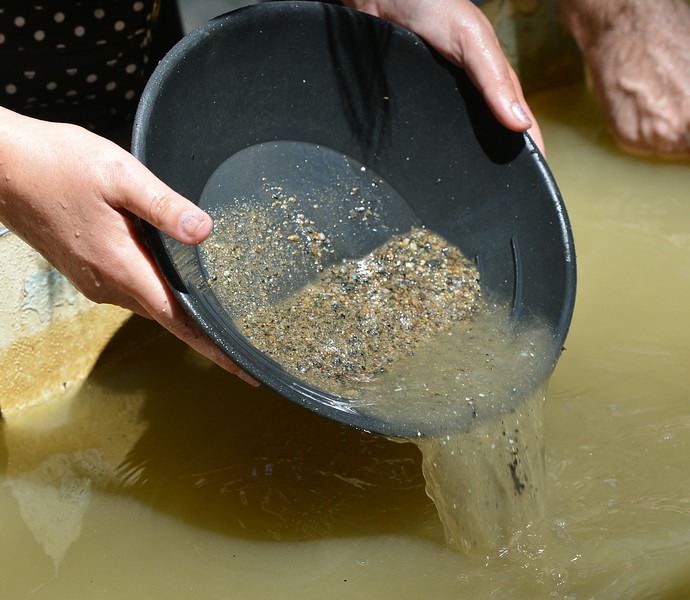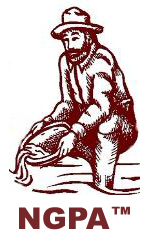Panning Your First One-Ounce Gold Nugget

There is no thrill like seeing a one-ounce nugget slowly show itself in the bottom of the pan. Although I am a mechanized miner and have found larger nuggets in my 30-foot long sluice box, it will not replace the thrill of that rich pan.
The Klondike goldfields of the Yukon Territory are small in area compared to the size of other goldfields. But it has produced the richest individual claims ever discovered. According to the Geological Survey of Canada, Memoir 284, the Lowe’s fraction produced over 20,000 ounces in an 86-foot fraction. Forty-ounce pans were not unusual!
While having a drink with Klondike miner John Erickson in Dawson City’s Eldorado hotel, he told me of his great thrill of panning 70 ounces of coarse gold in a quarter yard remnant (7 cubic feet) of the original paystreak left by the old-timers on Hunker Creek. Apparently it was left as a column to support the roof of an underground drift. Even though John and his partner Herman recover hundreds of ounces of gold in their mechanized operation, it was evident by the tone of his voice that seeing ounces of coarse gold and nuggets rattling in the pan was the height of his mining career. He averaged two ounces per pan!

Our little valley on upper Hunker creek (#24 pup) is only three miles upstream from John and Herman’s camp. After finding coarse gold in the bottom of a prospect shaft, I decided it was good enough to make a living from, using a mechanized operation.
To most, the gold mining game, even during the gold rush, was a losing proposition. You either have to be crazy or you have to enjoy the life style to stay in it; but, to those that persist, the rewards can be great. After observing many operations in the Klondike I decided the best odds for making a living were to start slow and pay-as-you-go. Eventually, I hand-mined enough gold to buy a loader-backhoe, and am now just managing to make a living.
It was during my hand mining phase that I panned the one-ounce nugget. Old-timers and greenhorns alike told me you are supposed to mine by the rules. You first mine the bottom of the valley and work your way up to the top. This will give you a bedrock drain for succeeding operations. But the one-in-eight foot drop in the valley suggested that this rule might not apply. The prospect shaft near the top of the valley where I hit coarse gold was only 11 feet deep. Because of the steep drop a bedrock drain was made in only one hundred feet along the valley bottom. A little work with a rented D-7 caterpillar took off the top three feet of moss and trees.
After a year of hauling the overburden out of the valley bottom. using a winch and an old ore car, I hit the paydirt. The ancient creek gravels below the overburden were only 18 inches thick and covered a bed of highly rotted foliated schist.
Testing the paystreak by panning and shoveling into a long-tom showed the gold to be of three basic types. The fine gold was either dendritic or crystalline, and the nuggets were usually rough. About 60% by weight was in coarse to nugget size. One-third pennyweight nuggets were common.
Every pan did not show a third pennyweight nugget. If it had that would mean that a cubic yard of paydirt would produce about two ounces of gold. Usually, I could take seven pans and not see a color, but the eighth pan would show a third pennyweight nugget. The average for the paydirt has been about six pennyweights per cubic yard. When hand mining, I generally follow the main section of the paystreak and pick up the rich spots. Mechanized mining cuts down this average even further because the bucket of a payloader is not as selective as a hand-shovel.
Working my way down the valley, instead of up the valley as the rules state, also had the advantage of working toward a richer paystreak because the most productive ground is generally at the mouth of the valley.
During the second year of hand mining in the valley, as I opened up a new section downstream, the structure of the bedrock changed from rotted schist to a hard blocky bedrock. In the paystreak on the foliated schist, the main body of placer gold extended from about six inches up into the alluvial gravel and about two inches into the soft rotted bedrock. Soon I discovered that even though the blocky bedrock was harder to work by hand, the gold was much coarser because it became trapped in the natural riffles formed by the large cracks. Also, a clay-like material with the consistency of peanut butter trapped flat nuggets on the surface of the bedrock.
The magnetite in this paystreak was excessive and in a crystalline form. It was so thick that it would rapidly pack the riffles of my long-tom. Fortunately, the gold was coarse and easy to trap. In short order, I had mined about five ounces with many one-pennyweight, to quarter-ounce nuggets.
When I came to the hard blocky bedrock, it had to be pried apart; and what little gravel was in the cracks was panned. Most pans produced coarse gold and nuggets.
A large piece of bedrock slanted upward, facing downstream like a giant Hungarian riffle. On the downstream side of this slab was just enough gravel to pan. If it is a good pan I can usually see a color or two as I start washing the gravel. But no colors showed themselves, and it looked like this would be a “thin” pan. As usual, a large amount of magnetite began to appear in the bottom of the pan. Slowly washing the magnetite to the side with a circular motion, I saw the first glint of gold. Successive washing slowly brought the nugget to light. Larger and larger it grew until I realized it was much larger than the 1/4 ounce nuggets I had been seeing. The gold scale showed it to be exactly one ounce.
Even though I will probably recover larger nuggets in my mechanized operation, it will not replace the thrill of panning my first one-ounce nugget.

